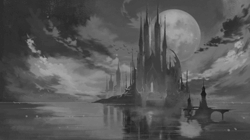 Bloodstained: Ritual of the Night reminded me why I actually enjoy my favorite genre.
Bloodstained: Ritual of the Night reminded me why I actually enjoy my favorite genre.
We live in confusing times. Just a few years back, it seemed like it was easy to define the direction of gaming. AAA was king, and, if anyone was “involved” in videogames, they knew that the next big thing was inevitably a franchise with intense graphics, open-world sandbox gameplay, and RPG-like elements. Or… something. Look, what’s important is that every gaming news site out there was telling us that the hottest titles available all cost the gross national product of South America, required twelve craptillion hours to produce, and were available now for your Playstation X or FourBox or whatever.
But things are different now. It may just be my old man imagination, but it seems like the videogame industry has finally adjusted to accommodate both AAA games and less intensive, but dramatically easier to produce, “indie” games. (In many cases, these “indie” games aren’t independently produced at all, but it seems like such an unintended slight to refer to them as “budget” or otherwise lesser titles. Though one could suppose that the “budget” thing really is the biggest factor here…) Back in the Playstation 2 days, it was newsworthy that Katamari Damacy was a “budget” title at its initial $20 MSRP. Now, presumably thanks to the advent of digital storefronts and more accessible development tools, games that could likely be best described as “light” are available at $20 just as often as the latest release drops on the same storefront at $60 (or $90 for that all-important day one edition). This has had the wonderful side effect of reviving certain genres and playstyles, so “the arcade experience” has finally resurfaced along with other categories that include “pretty much Zelda” and “shoot ‘em up (without exploitation)”. And, of course, the metroidvania has returned to us. In fact, the metroidvania has returned to us in spades.
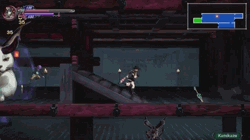 It seems like there is a new metroidvania released every month (every seven seconds come Fall). And, like a sucker, I have a tendency to throw myself into about every third one that comes down the pike. I like metroidvanias! I have liked them since Super Metroid (“What about the original Metroid?” “We don’t talk about that”). And I suppose that, like a plumber that is permanently thirsty after an unfortunate detour through Desert Land, I am always going to be starved for more metroidvania content. I can’t even say that I will wait to finish one metroidvania before I start the next one, as it appears I am playing another metroidvania while I am writing this very article. Load times are writing times, people! I’m a very busy man, and I have to see that sweet 100% map completion achievement somehow!
It seems like there is a new metroidvania released every month (every seven seconds come Fall). And, like a sucker, I have a tendency to throw myself into about every third one that comes down the pike. I like metroidvanias! I have liked them since Super Metroid (“What about the original Metroid?” “We don’t talk about that”). And I suppose that, like a plumber that is permanently thirsty after an unfortunate detour through Desert Land, I am always going to be starved for more metroidvania content. I can’t even say that I will wait to finish one metroidvania before I start the next one, as it appears I am playing another metroidvania while I am writing this very article. Load times are writing times, people! I’m a very busy man, and I have to see that sweet 100% map completion achievement somehow!
But that’s the exact problem I had that I hadn’t realized until playing Bloodstained: Not all metroidvanias are about completion.
I admit that I have played a number of metroidvanias in recent years, and now I’m pretty sure that I played them all wrong. For an easy example, I can look at Metroid 2, Metroid 2, and Metroid 2, all games that were reviewed recently (“recently”) for this site. And if you look at those articles, you will note that two out of three of those games were completed and reviewed (“reviewed”) within days of their release. How did I do that? Well, obviously, I completed the titles as quickly as possible. Why did I do that? Well, that’s simple: it’s a videogame, it’s a challenge, and you’re winning if you finish the challenge the fastest. Yes, I can and absolutely will go back to “100%” the title, but I’m going to do that as quickly as possible, too. I noticed that door I couldn’t open quite yet, you better believe I’m going to come back later and nab every last expansion pack and powerup bonus. After I’m all done with that, I’m going to check a FAQ and/or forums to learn what I missed, and maybe review a few speedrun strats. Then, after I’ve seen my own fastest run through the latest SR388, then, maybe, I’ll put it all down, call the game complete, and see you next mission. …Which might happen about seven seconds later with a certain robot named Fight…
And Bloodstained taught me that no, you’re wrong Goggle Bob. Stop and smell the roses (that may or may not be expies for medusa heads).
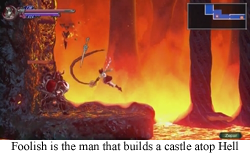 Let’s address one thing before we go any further: Bloodstained: Ritual of the Night is by no means a perfect game. For one thing, the bosses suck in all kinds of different ways. Practically every creature has way too much HP, you see the same stupid patterns over and over again, and there is just no universe where certain samurai bosses needed “reprise” fights (particularly in light of the Boss Rush mode). I’m pretty sure I distinctly enjoyed, like, one boss battle, and everything else was either way too stupid/easy or way too frustrating thanks to stupidity/endurance. And I’m playing on Switch, so let me tell you about how, every once in a while, I am reminded of Super Castlevania and the kind of slowdown that I thought was relegated to games from thirty freaking years ago. Oh, and speaking of thirty years ago game design: there is the occasional bit in Bloodstained that might have been more at home back in Simon’s Quest, the infamous Castlevania title that told players to literally bang their heads against the wall. At one point, I (a person who famously plays a lot of videogames) was completely stuck for finding a solution to my current predicament, and it turns out the resolution involved talking to a random NPC out in the castle boonies. Why would I ever do that? Who knows, but I couldn’t see a single clue to lead me in that direction, so I was stuck randomly wandering all over the map.
Let’s address one thing before we go any further: Bloodstained: Ritual of the Night is by no means a perfect game. For one thing, the bosses suck in all kinds of different ways. Practically every creature has way too much HP, you see the same stupid patterns over and over again, and there is just no universe where certain samurai bosses needed “reprise” fights (particularly in light of the Boss Rush mode). I’m pretty sure I distinctly enjoyed, like, one boss battle, and everything else was either way too stupid/easy or way too frustrating thanks to stupidity/endurance. And I’m playing on Switch, so let me tell you about how, every once in a while, I am reminded of Super Castlevania and the kind of slowdown that I thought was relegated to games from thirty freaking years ago. Oh, and speaking of thirty years ago game design: there is the occasional bit in Bloodstained that might have been more at home back in Simon’s Quest, the infamous Castlevania title that told players to literally bang their heads against the wall. At one point, I (a person who famously plays a lot of videogames) was completely stuck for finding a solution to my current predicament, and it turns out the resolution involved talking to a random NPC out in the castle boonies. Why would I ever do that? Who knows, but I couldn’t see a single clue to lead me in that direction, so I was stuck randomly wandering all over the map.
And… I enjoyed that.
I didn’t know what I was doing, and I enjoyed that.
It has been said a thousand times that the appeal of a number of videogames and their associated genres (that is to say, all the games that copied the original title until they were defined as belonging to a genre) was always their level of freedom. Grand Theft Auto 3 is a title that was probably completed by about 25% of its players, but was somehow still enjoyed for hours upon hours thanks to all the fun one could have with a cheat code and a rocket launcher. Skyrim probably has something to do with terrifying dragons, but it is also a cheese wheel discovery simulator. And The Legend of Zelda: Breath of the Wild allows for a Link that can ignore the literal apocalypse and dick around discovering tree poop for entire months. Freedom is the name of the game!
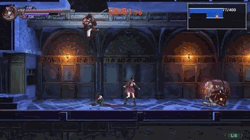 But “freedom” is something that is generally lacking in 2-D adventures. Mario might have been able to find a key or two in his 2-D outings, but those levels were still “courses”, not “environments” (and you could likely claim the collectathons of the late SNES era were Mario and others growing against their 2-D confines). And while there were a few 2-D games based on exploring, that entire perspective has always been about finding the next checkpoint or powerup that helps you to find the next powerup. There’s a reason that Metroid rewards you with its heroine in her knickers for a speedy run through Zebes, and totally ignores how you used your grappling beam to teach the etecoons how to love. The point of a 2-D adventure is not to “have fun” in the environments, it is to find the optimal way to move forward, to gain more skills, and then see what’s around that next bend. The fun is in the discovery of new areas and powers, not in simply reveling in the areas you’ve already traversed.
But “freedom” is something that is generally lacking in 2-D adventures. Mario might have been able to find a key or two in his 2-D outings, but those levels were still “courses”, not “environments” (and you could likely claim the collectathons of the late SNES era were Mario and others growing against their 2-D confines). And while there were a few 2-D games based on exploring, that entire perspective has always been about finding the next checkpoint or powerup that helps you to find the next powerup. There’s a reason that Metroid rewards you with its heroine in her knickers for a speedy run through Zebes, and totally ignores how you used your grappling beam to teach the etecoons how to love. The point of a 2-D adventure is not to “have fun” in the environments, it is to find the optimal way to move forward, to gain more skills, and then see what’s around that next bend. The fun is in the discovery of new areas and powers, not in simply reveling in the areas you’ve already traversed.
But when I got stuck in Bloodstained, I discovered that I actually liked playing around in this haunted castle. I didn’t have any new abilities. I didn’t have some grinding goal. In fact, I didn’t have a damn clue where I was supposed to be heading, or what I was supposed to be doing. But I was at least at the point in the game where Miriam’s moveset is more robust than your typical Castlevania protagonist. It was fun to play as Miriam, and, as a result, it was fun to revisit older areas with Miriam. It was fun to see monsters that had previously been a detriment, and were now a possible source for new and exciting items. It was fun to see old areas, and enjoy the ambiance of any given room in a capacity beyond just randomly hitting walls and hoping for a meat drop. 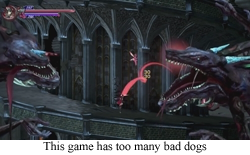 It was fun! It was fun exploring the world of Bloodstained not for some overarching goal, but just exploring for the sake of exploring! Like some kind of fancy-pants, city-slicker 3-D game. And even if I wasn’t making any “plot” progress, I was still collecting a host of materials, shards, and experience from my unplanned sojourn. Even when I’m not doing anything, I’m doing something! That’s the sign of a good videogame!
It was fun! It was fun exploring the world of Bloodstained not for some overarching goal, but just exploring for the sake of exploring! Like some kind of fancy-pants, city-slicker 3-D game. And even if I wasn’t making any “plot” progress, I was still collecting a host of materials, shards, and experience from my unplanned sojourn. Even when I’m not doing anything, I’m doing something! That’s the sign of a good videogame!
And, ultimately, I feel like that is the source of the good from the “vania” side of the metroidvania equation. My personal theory for years has been that Metroid games are better than Castlevania games. Why? Well, if you find a Super Missile container hiding behind a wall while exploring Zebes, you can enjoy that Super Missile upgrade whether you’re at the start of the adventure or heading toward the final confrontation. Meanwhile, while exploring Castlevania (or… Igavania? Huh?), you might find a +1 sword hidden in a concealed room. But you’ve already discovered a +4 sword. Why would you ever bother with such a piddling weapon? Congratulations, you found the secret, and it’s completely useless. Why did you even bother exploring?
But that’s only true in a bad Castlevania. In a game where your every undertaking is enjoyable, then finding even the crappiest of swords is enjoyable, because you enjoyed getting there. Bloodstained: Ritual of the Night is such a game. Bloodstained is fun to play, and, in that way, encourages the player to stop and take it all in. Every movement, every monster, every gigantic severed dog’s head (it’s a weird game) contributes to an overall feeling that is bizarrely welcoming. Yes, Bloodstained predominantly takes place in a deadly castle filled with murder-beasts, but it also feels like Iga is inviting you to his magical kingdom (that incidentally contains giant werewolves). It’s fun to play Bloodstained, and it’s fun to be in Bloodstained.
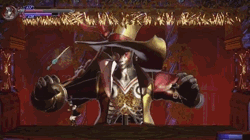 I feel like that is something I forgot along the way. Through the portable metroidvanias, through the reimaginings of other titles, and through the current bounty of excellent indie titles, I’ve been focusing on “beating” these ‘vanias. And, while that is a perfectly valid approach to any videogame, somewhere I lost the simple ability to enjoy the moment. Stop, smell the zombies. and encounter a castle on its own terms. With an interesting moveset and environments, Bloodstained encourages exploration as slow and meticulous as the effort it inevitably took to build this kingdom.
I feel like that is something I forgot along the way. Through the portable metroidvanias, through the reimaginings of other titles, and through the current bounty of excellent indie titles, I’ve been focusing on “beating” these ‘vanias. And, while that is a perfectly valid approach to any videogame, somewhere I lost the simple ability to enjoy the moment. Stop, smell the zombies. and encounter a castle on its own terms. With an interesting moveset and environments, Bloodstained encourages exploration as slow and meticulous as the effort it inevitably took to build this kingdom.
Bloodstained isn’t a perfect game. It might not even be a truly great game. But it is a game that encouraged me to look at games differently, and that’s always perfect.
FGC #442 Bloodstained: Ritual of the Night
- System: Xbox One, Playstation 4, PC, and Switch if you’re nasty. Vita and WiiU are right out.
- Number of players: There’s some manner of multiplayer somewhere in here, right? For all I care, it’s single player, but I’m pretty sure there was a stretch goal somewhere in there…
- Kickstart This: Yes, I contributed money to see this game produced. Do I feel that influences my own opinion on the game? No. Considering I am really terrible about checking any developer update emails, I’m going to go ahead and say my “production credit” is just an eternal reminder that I reserved this game way early.
- Favorite Shard: Being able to manually “aim” Miriam’s hand is the perfect middle ground between your average metroidvania and Samus Returns’ continual aiming. And the best use of aiming Miriam’s hand is to shoot a bevy of True Arrows right at your opponents. There’s nothing finer than seeing a goopy zombie puddling around with arrows in its knees.
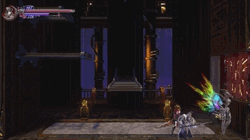 Boss Battler: It seems like the bosses that were most difficult in Bloodstained: Curse of the Moon have been converted to extremely easy encounters for this adventure. In particular, Andrealphus, the bird-armor thing, goes from the biggest bad to the smallest chump. Though I suppose a lack of pits really takes something away from the poor guy…
Boss Battler: It seems like the bosses that were most difficult in Bloodstained: Curse of the Moon have been converted to extremely easy encounters for this adventure. In particular, Andrealphus, the bird-armor thing, goes from the biggest bad to the smallest chump. Though I suppose a lack of pits really takes something away from the poor guy…- Say something mean: The entire first area is terrible. Bloodstained offers easily the worst opening I have seen in a videogame in years. Miriam starts off too limited, the areas are claustrophobic, and the boss of the area is just the worst. Did someone demand a really s*** prologue area? Because we got a really s*** prologue area.
- Did you know? While Dracula technically doesn’t appear in this game, the ultimate impetus for the final villain of the game is very similar to the motivations of Bram Stoker’s Dracula. So even when the count doesn’t show up, it seems he has an influence on final bosses.
- Would I play again: I feel like I got everything I wanted out of this castle, but I’m certainly going to dive in when further character DLC drops. I will be returning to this magical land once again. Actually, come to think of it…
What’s next? We’re going to continue our Bloodstained coverage. Kinda. Next up is Castlevania: Order of Ecclesia, and we’re going to play a little game of compare and contrast between the seemingly very similar protagonists. Please look forward to it!
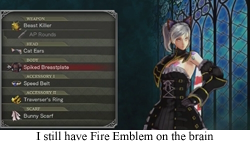

[…] for public publication. And GIFs! I love my GIFs! I can’t imagine some of these articles without angry hyper-realistic cats or Pac-Man waddling along. And Lord knows Disney (forever may The Mouse reign) might have an issue […]
[…] Alucard-like protagonists in the Castlevania franchise. Soma is an Alucard. Shanoa is an Alucard. Castlevania-wannabe Miriam is an Alucard. But claiming there are only two options is reductive. John Morris of Portrait of […]